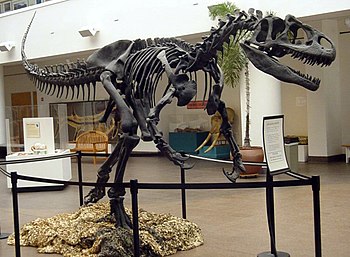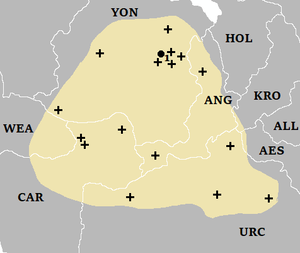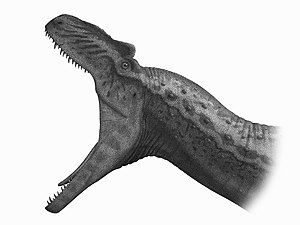Joanusaurus
| Joanusaurus | |
|---|---|

| |
| Mounted J. davignoni skeleton cast, Collinebourg Natural History Museum | |
| Scientific classification | |
| Kingdom: | |
| Phylum: | |
| Class: | |
| Order: | |
| Family: | |
| Genus: | Joanusaurus Thibault d'Avignon, 1878
|
| Type species | |
| †Joanusaurus davignoni Thibault d'Avignon, 1878
| |
| Other species | |
| |
Joanusaurus is a genus of large joanusaurid theropod dinosaur that lived 150 to 130 million years ago during the Late Jurassic and Early Cretaceous epoch in modern day Levantia and Sarpedon on a supercontinent known as Sarpolevantia. The name "Joanusaurus" means "Joanus' lizard", named in honour of the founder of Yonderre. The first fossil remains that could definitively be ascribed to this genus were described in 1878 by Yonderian paleontologist Thibault d'Avignon. As one of the first well-known theropod dinosaurs, it has long attracted attention outside of paleontological circles. Joanusaurus was a large bipedal predator. Its skull was light, robust and equipped with dozens of sharp, serrated teeth. It averaged 10 meters (33 ft) in length, though fragmentary remains suggest it could have reached over 12 m (39 ft). Relative to the large and powerful hindlimbs, its three-fingered forelimbs were small, and the body was balanced by a long and heavily muscled tail. It is classified as a joanusaurid, a type of carnosaurian theropod dinosaur. The bulk of Joanusaurus remains have come from Central Levantia's Greater Levantine Formation, with material also known from northern Caphiria. Joanusaurus has been the National Dinosaur of Yonderre since 1932.
As the most abundant large predator in the Greater Levantine Formation, Joanusaurus was at the top of the food chain, probably preying on contemporaneous large herbivorous dinosaurs, and perhaps other predators. Potential prey included ornithopods, stegosaurids, and sauropods. Some paleontologists interpret Joanusaurus as having had cooperative social behavior, and hunting in packs, while others believe individuals may have been aggressive toward each other, and that congregations of this genus are the result of lone individuals feeding on the same carcasses.
Description

Joanusaurus was a typical large bipedal theropod, having a massive skull on a short neck, a long, slightly sloping tail, and reduced forelimbs. Joanusaurus davignoni, the best-known species, had an average length of 9.7 meters (32 feet), with the largest definitive Joanusaurus specimen (JSNH 432) estimated at 11.6 meters (38 feet) long, with an estimated weight of 2.5 metric tons (2.7 short tons). In his 1976 monograph on Joanusaurus, Cadeaux mentioned a range of bone sizes which he interpreted to show a maximum length of 12 to 13 m (39 to 43 ft). As with dinosaurs in general, weight estimates are debatable, and since 1980 have ranged between 1,500 kilograms (3,300 pounds), 1,000 to 4,000 kg (2,200 to 8,800 lb), and 1,010 kilograms (2,230 pounds) for modal adult weight (not maximum). In a 2005 article, Johann Fürster, a specialist on the Greater Levantine Formation, suggests that 1,000 kg (2,200 lb) is reasonable for large adults of J. davignoni, but that 700 kg (1,500 lb) is a closer estimate for individuals represented by the average-sized thigh bones he has measured, although Fürster's finding have been met with critique from other experts.
Examining individual Joanusaurus fossils found that the specimens from northern Caphiria are generally smaller than those from Vollardic Mountains in Yonderre or Great Lime Quarry in Avonia, but the shapes of the bones themselves did not vary between the sites. The Joanusaurus skulls had a pair of horns above and in front of the eyes. These horns were composed of extensions of the lacrimal bones, and varied in shape and size. There were also lower paired ridges running along the top edges of the nasal bones that led into the horns. The horns were probably covered in a keratin sheath and may have had a variety of functions, including acting as sunshades for the eyes, being used for display, and being used in combat against other members of the same species (although they were fragile). There was a ridge along the back of the skull roof for muscle attachment, as is also seen in caphirosaurids.
The skull and teeth of Joanusaurus were modestly proportioned for a theropod of its size. Paleontologist Phillipe d'Everard gives a length of 845 mm (33.3 in) for a skull belonging to an individual he estimates at 7.9 m (26 ft) long. Each premaxilla (the bones that formed the tip of the snout) held five teeth with D-shaped cross-sections, and each maxilla (the main tooth-bearing bones in the upper jaw) had between 14 and 17 teeth; the number of teeth does not exactly correspond to the size of the bone. Each dentary (the tooth-bearing bone of the lower jaw) had between 14 and 17 teeth, with an average count of 16. The teeth became shorter, narrower, and more curved toward the back of the skull. All of the teeth had saw-like edges. They were shed easily, and were replaced continually, making them common fossils. Its skull was light, robust and equipped with dozens of sharp, serrated teeth. Its skull averaged 1 m (3.3 ft) long but could possibly reach 1.5 m (4.9 ft).
Discovery and history
Early finds in Levantia

The discovery and early study of Joanusaurus came in 1878 when a friend of the paleontologist Thibault d'Avignon bought a petrified bone from a curio shop in Koop, Yonderre. Bones such as this had long been known to the populace of the industrious Vollardic Mountains and were known as the bones of ancient giants in local folklore. When examined by d'Avignon he recognized it as the radius bone of a large theropod and tentatively assigned it to the genus Vollardisaurus. d'Avignon secured funding for an expedition to the Vollardic Mountains in August of 1878 where, aided by local silver miners, more remains were uncovered. In September of 1878 d'Avignon's expedition uncovered remains of a Joanusaurus in a disused silver mine. With about 31% of the skeleton present in the form of fragmentary bones including parts of three vertebrae, a rib fragment, a toe bone, and, most useful for later discussions, a near-complete skull, d'Avignon pronounced this to be a new species entirely and gave these remains the formal name Joanusaurus davignoni. The species name means "Joanus' lizard" and is named in honour of Joanus de Martigueux, founder of Yonderre. The type name davignoni is named for d'Avignon himself.
Further digs in and around the site of the discovery of the first Joanusaurus revealed more remains of Joanusaurus and Vollardisaurus, as well as remains of the sauropod Makrylaimis and smaller fossil matter like fossilized plant matter and coprolites. Later digs around the Greater Levantine Formation uncovered more remains of the Joanusaurus including the most complete theropod ever uncovered at the time, a Joanusaurus named GLJN 203 with an approximate 85% completeness. A new subspecies was discovered in 1931 in Great Lime Quarry, Avonia, by Jour & Leon. Named Joanusaurus angleii, the new subspecies differs from J. davignoni in several anatomical details, including a jugal or cheekbone with a straight lower margin.
Caphiria
A 1919 expedition led by Yonderian paleontologist Phillipe d'Everard uncovered remains of Joanusaurus in the Aravera mountains of the Caphirian province Iscasta. d'Everard initially viewed the specimen as a subadult J. davignoni, but upon closer inspection it was recategorized as a new subspecies, J. iscastae. J. iscastae differs from J. davignoni by its longer snout and smaller physical stature, with the largest known specimen, CJI 209, being 9 meters (30 ft) long as opposed to the the largest J. davignoni, JSNH 432, estimated at 11.6 meters (38 feet) long. Remains of at least 15 individual Joanusaurus specimens have been uncovered in Caphiria since 1919, the latest, CJHM 594, in 2018.
Big Yon

Big Yon is a 95% complete Joanusaurus with several interesting pathologies presesnt in the skeleton. Paleontologists were able to piece together a hypothetical life story for Big Yon based on these pathologies that was turned into a 45 minute long television documentary in 2000 by Primo Kino as the Life and Death of Big Yon.
Big Yon was discovered on accident in 1980 by miners in Marsbury in the northern Ionian Mountains, Urcea. A joint team of Yonderian and Urcean paleontologists painstakingly uncovered the specimen, named UJMN 872 and quickly nicknamed Big Yon. The specimen measured about 9 meters (about 29 ft) in length and showed remarkable signs of healed or partially healed injuries. Nineteen of its bones were broken or showed signs of infection, which may have contributed to Big Yon's death. Pathologic bones included five ribs, five vertebrae, and four bones of the feet; several damaged bones showed osteomyelitis, a bone infection. A particular problem for the living animal was infection and trauma to the right foot that probably affected movement and may have also predisposed the other foot to injury because of a change in gait. Big Yon had an infection on the first phalanx on the third toe that was afflicted by an involucrum.[1]
Modern finds
Because of its evident abundance, more than a hundred individual Joanusaurus specimens have been uncovered in the Greater Levantine Formation, particularly in the Vollardic Mountains. The period since Cadeaux's 1976 monograph has been marked by a great expansion in studies dealing with topics concerning Joanusaurus in life (paleobiological and paleoecological topics). Such studies have covered topics including skeletal variation, growth, skull construction, hunting methods, the brain, and the possibility of gregarious living and parental care. Reanalysis of old material (particularly of large Joanusaurus specimens), new discoveries in Avonia, and several very complete new specimens have also contributed to the growing knowledge base.
Classification

Joanusaurus is classified taxonomically as a member of joanusauridae, making it a derived joanusaur.
| Joanusauroidae |
| |||||||||||||||||||||||||||
Paleobiology

The wealth of Joanusaurus fossils, from nearly all ages of individuals, allows scientists to study how the animal grew and how long its lifespan may have been. Remains may reach as far back in the lifespan as eggs—crushed eggs from Vollardie have been suggested as those of Joanusaurus. Based on histological analysis of limb bones, bone deposition appears to stop at around 22 to 28 years, which is comparable to that of other large theropods like Caphirosaurus. From the same analysis, its maximum growth appears to have been at age 15, with an estimated growth rate of about 150 kilograms (330 lb) per year.
Paleontologists accept Joanusaurus as an active predator of large animals. There is dramatic evidence for Joanusaur attacks on Stegosaurus, including a Joanusaurus tail vertebra with a partially healed puncture wound that fits a Stegosaurus tail spike, and a Stegosaurus neck plate with a U-shaped wound that correlates well with a Joanusaurus snout. Sauropods seem to be likely candidates as both live prey and as objects of scavenging, based on the presence of scrapings on sauropod bones fitting Joanusaurus teeth well and the presence of shed Joanusaurus teeth with sauropod bones. However, as Cadeaux noted in 1981, Joanusaurus was probably not a predator of fully grown sauropods, unless it hunted in packs, as it had a modestly sized skull and relatively small teeth, and was greatly outweighed by contemporaneous sauropods.
It has been speculated since the 1970s that Joanusaurus preyed on sauropods and other large dinosaurs by hunting in groups. Such a depiction is common in semitechnical and popular dinosaur literature. C.G. Kier has extended social behavior to parental care, and has interpreted shed Joanusaurus teeth and chewed bones of large prey animals as evidence that Joanusaurus adults brought food to lairs for their young to eat until they were grown, and prevented other carnivores from scavenging on the food. However, there is actually little evidence of gregarious behavior in theropods, and social interactions with members of the same species would have included antagonistic encounters, as shown by injuries to gastralia and bite wounds to skulls (the pathologic lower jaw named Labrosaurus ferox is one such possible example). Such head-biting may have been a way to establish dominance in a pack or to settle territorial disputes.
See also
Notes
- ↑ Horner et al.: The Curious Case of Big Yon the Joanusaurus, University of Collinebourg. 1989.


